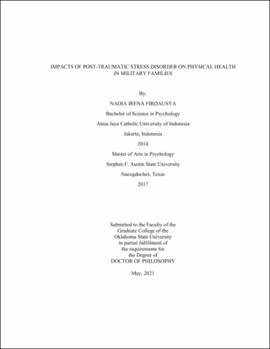| dc.contributor.advisor | Washburn, Isaac | |
| dc.contributor.author | Firdausya, Nadia Irena | |
| dc.date.accessioned | 2021-09-24T13:33:00Z | |
| dc.date.available | 2021-09-24T13:33:00Z | |
| dc.date.issued | 2021-05 | |
| dc.identifier.uri | https://hdl.handle.net/11244/330872 | |
| dc.description.abstract | Existing studies have documented the adverse impacts of PTSD both in military service members as well as their families. The impacts of PTSD on physical health were only observed among the service members and veterans. There are major gaps in the field including in the understanding of mechanism that connects PTSD and physical health consequences, as well as evidence of spillover impacts of PTSD on physical health within the family of service members. The current study addresses this gap through investigation on the role of physiological functions including physiological responses (e.g., blood pressure), pre-disease biomarkers (e.g., inflammation), and evaluating risk for and the impacts of PTSD. The current study also proposed a mechanism to understand the connection between PTSD and pathology through those variables. Further, comparisons of the proposed model across different sociodemographic groups were also conducted. A secondary data analysis from CERNER Health Facts, specifically using path and multiple group path analyses, was utilized to attain the goal of the study. Findings yielded that physiological profiles, including pulse rate and leukocyte count, can provide insight into the risk of PTSD. Following PTSD diagnosis, alterations in pulse rate and N/L ratio were observed, confirming that PTSD altered different physiological functions. PTSD was also directly connected to pathology. Further, these physiological responses following PTSD were found to be connected and provided insights on the mechanisms of the connection between PTSD and pathology. However, comparisons of proposed model across different sociodemographic groups indicated that the proposed model needs to be used with caution as it did not capture the mechanisms equally across different groups. Nevertheless, it provides insights into the unexplored area. The findings from this study contributed to important movement for the integration between mental and physical health services especially in PTSD treatments. Monitoring of physiological markers of individuals at risk or diagnosed with PTSD can help minimize further damaged on physical health. | |
| dc.format | application/pdf | |
| dc.language | en_US | |
| dc.rights | Copyright is held by the author who has granted the Oklahoma State University Library the non-exclusive right to share this material in its institutional repository. Contact Digital Library Services at lib-dls@okstate.edu or 405-744-9161 for the permission policy on the use, reproduction or distribution of this material. | |
| dc.title | Impacts of post-traumatic stress disorder on physical health in military families | |
| dc.contributor.committeeMember | Gallus, Kami | |
| dc.contributor.committeeMember | Gardner, Brandt | |
| dc.contributor.committeeMember | Salak-Johnson, Janeen | |
| osu.filename | Firdausya_okstate_0664D_17213.pdf | |
| osu.accesstype | Open Access | |
| dc.type.genre | Dissertation | |
| dc.type.material | Text | |
| dc.subject.keywords | family | |
| dc.subject.keywords | military | |
| dc.subject.keywords | physical health | |
| dc.subject.keywords | ptsd | |
| thesis.degree.discipline | Human Sciences | |
| thesis.degree.grantor | Oklahoma State University | |
